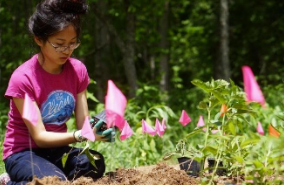The Pennies for Monarchs Seed to Milkweed Program
Why aren’t monarch butterflies visiting our schoolyard? What can we do about it?
Imagine if every school in America planted milkweed as a part of their science curriculum. Pennies for Monarchs is imagining just that. This will make a real impact for the declining monarch population, but just as importantly it will deeply impact students by empowering them as stewards of seedlings and land. The Seed to Milkweed School Program is a fully supported pathway for teachers and students to join the movement to restore monarch habitat.
This science standards-aligned, middle school unit starts out with students analyzing a graph about the declining monarch population. Monarchs have declined by about 80% in the last 20 years. The phenomenon of declining monarchs sparks questions about what could be causing this decline. The unit project is to create monarch habitat in an area of the schoolyard. In order to do this, students will need to figure out the reasons why monarchs are in decline by learning about monarch’s habitat needs and the ecosystems they depend on. On the first day of the unit, students plant milkweed seeds in containers in the classroom and begin their observations of monarch eggs, in butterfly enclosures, also in the classroom.
Students begin by investigating the question: Why aren’t monarchs visiting our schoolyard? This question leads students to wondering what monarchs eat. How do monarchs get the food molecules they need to grow and move? Observations of the growing monarch caterpillars being raised in the classroom, ground their learning in this part of the unit. They learn that many insects have co-evolved with specific plants-these plants, known as host plants, are often the only kind of food that insect is capable of eating in its larval stage. Monarchs have co-evolved with milkweed: it’s the only food source monarch caterpillars can eat. Monarch butterflies drink nectar from a variety of plants. By doing an investigation involving yeast, students figure out that monarch caterpillars change the food molecules from milkweed leaves into molecules that build their body matter or release energy for movement, during the process of cellular respiration. Through a highly active game, students learn about how populations of milkweed affect populations of monarchs: when milkweed populations decrease, so do monarch populations.
The next question becomes: Why isn’t milkweed growing in our schoolyard? This question leads students to investigate the question: how do milkweeds get the food molecules they need to grow and thrive? Observations of their growing milkweed seedlings grounds their learning in this part of the unit. Milkweed makes its own food using energy from the sun. Like all plants, milkweed uses energy from the sun to turn carbon dioxide and water into food molecules during the process of photosynthesis. Milkweed changes these food molecules into molecules that build its body or release energy. All the energy that milkweed and monarchs use can be traced back to the sun. Through analyzing aerial images of the area surrounding their school as well as images that show development across the US students observe that formerly natural areas that likely had milkweed, have now been developed. They also read about the effects of pesticides, used in industrial agriculture, on milkweed.
Students learn more about the work that is being done by scientists and ordinary people in the US and Mexico to create monarch habitat and protect monarchs. In groups, they write a Schoolyard Monarch Habitat proposal, explaining the science of why monarchs need milkweed. During an event open to the community, they present their plans to peers, school administrators and other relevant community stakeholders. School administrators and others may have feedback for groups on their Schoolyard Monarch Habitat proposals. The groundwork is laid for students to implement their Schoolyard Monarch Habitat plan. When the milkweed seedlings are mature, they will be transplanted to the schoolyard.
Teachers who participate in the Seed to Milkweed School Program, will receive:
The Seed to Milkweed Unit, which includes everything teachers need to teach including teacher guides, a supporting powerpoint for each lesson and a student investigation notebook with all student handouts.
Expert guidance on growing milkweed in the classroom and transplanting it to the schoolyard.
All materials needed for growing milkweed in the classroom including soil, seeds, and containers.
A small number of local, wild monarch eggs (monarchs should NOT be purchased online) and a butterfly enclosure
Are you an interested middle school teacher? We’re looking for teachers to pilot Seed to Milkweed next year! Please get in touch! Click here to email us today with any questions. Ready to go? Click “Donate” below and select “Seed to Milkweed” to get your starter package!
After inspiring your students, ask them to give back.
Click here to download information about the Pennies for Monarchs & PTA Penny War, and then contribute here to receive everything you need to get it going.



